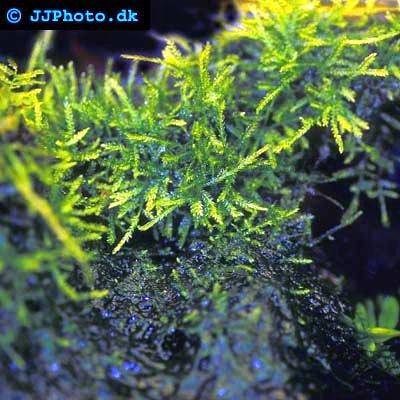Vesicularia dubyana
Scientific name: Vesicularia dubyana
Family: Hypnaceae
Maximum size reached under cultivation: 0 - 5 cm (0 - 1.97 inch)
014
Recommended pH range: 6.5 - 7.2
Recommended water hardness: 4 - 30°dGH (71.43 - 535.71ppm)
0°C 32°F30°C 86°F
Recommended temperature range: 21 - 27 °C (69.8 - 80.6°F)
Preferred propagation method: Divisions
Native to: South Asia
Growth rate: Slow
Recommended substrate: Rocky
Lighting requirements: Bright
Ideal placement in tank: Foreground
Family
Hypnaceae
Common Name
Java Moss
Propagation
Java Moss can be propagated by dividing it into smaller clumps. To do this, gently break off sections of the moss by hand or use scissors to cut it into smaller portions. These pieces can then be attached to rocks, driftwood, or other surfaces in the aquarium using fishing line, thread, or rubber bands. Over time, the moss will establish itself and attach naturally to the surface. Additionally, Java Moss can thrive as a floating plant in tanks, especially in fry rearing setups where it provides shelter for young fish. Its versatility makes it suitable for a wide range of aquarium layouts.
Difficulty
Java Moss is generally considered a medium difficulty plant, but this largely depends on water conditions. While it can adapt to different environments, it thrives best in soft, slightly acidic water with good lighting. In harder, more alkaline waters, Java Moss may develop a brownish color but will continue to grow nonetheless. Regular maintenance, such as trimming, is recommended to keep it healthy and promote proper growth.
Short Description
Java Moss is a highly adaptable and versatile plant that is a favorite for aquascaping. It can be attached to almost any surface, including rocks, wood, and even filter intake pipes, allowing aquarists to create natural-looking aquascapes. This plant is slow-growing and thrives under bright lighting, although it can tolerate lower light conditions. However, in harder and alkaline water, its color may shift to brownish tones. Despite this, the plant will remain healthy and continue growing. It's ideal for adding texture and dimension to a tank and is often used in breeding tanks to provide cover for fry. For optimal growth, attach Java Moss to rocks and supplement with fertilizers as needed.
Q&A
On March 25th 2011, the following question was added due to merging aqua-fish.net/answers with related pages.
How does Java Moss look?
Answer: Java Moss has tiny root-like structures and is frequently used to create lush carpets in aquariums. Its color varies depending on lighting and water quality. Under good conditions, it remains green, while poor water quality or suboptimal lighting can turn it brown. However, a brown color does not necessarily indicate that the plant is dead; it will continue to grow despite the color change.
